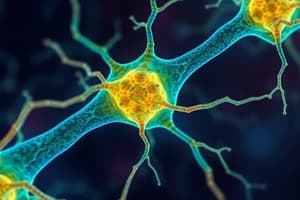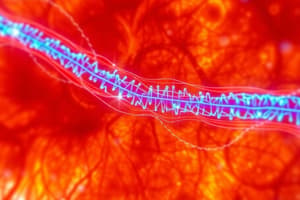Podcast
Questions and Answers
What triggers the nerve impulses in olfactory transduction?
What triggers the nerve impulses in olfactory transduction?
- Activation of taste buds by tastants
- Release of neurotransmitters from gustatory cells
- Opening of potassium channels in olfactory cilia
- Binding of odorants to G protein-linked receptors (correct)
Which factor contributes to the rapid adaptation in olfactory receptors?
Which factor contributes to the rapid adaptation in olfactory receptors?
- The presence of cAMP
- The exocytosis of synaptic vesicles
- Low threshold for odor detection (correct)
- Sodium influx through voltage-gated channels
What is the primary function of gustatory microvilli in taste perception?
What is the primary function of gustatory microvilli in taste perception?
- To initiate olfactory transduction
- To support olfactory nerve cells
- To transmit light for vision
- To bind tastants in saliva (correct)
Which taste type has the lowest threshold for detection?
Which taste type has the lowest threshold for detection?
How do sour tastants primarily affect gustatory receptor cells?
How do sour tastants primarily affect gustatory receptor cells?
What occurs during the adaptation of olfactory receptors?
What occurs during the adaptation of olfactory receptors?
Which of the following statements about adaptation in gustation is correct?
Which of the following statements about adaptation in gustation is correct?
What role does cyclic adenosine monophosphate (cAMP) play in olfactory transduction?
What role does cyclic adenosine monophosphate (cAMP) play in olfactory transduction?
Why are thresholds for salty and sweet substances relatively higher than for bitter or sour?
Why are thresholds for salty and sweet substances relatively higher than for bitter or sour?
Which mechanism is primarily responsible for depolarization in taste perception?
Which mechanism is primarily responsible for depolarization in taste perception?
Flashcards are hidden until you start studying
Study Notes
Vision: Phototransduction and Adaptation
- Phototransduction process: Cis-retinal transforms into trans-retinal upon absorbing light, initiating a series of chemical changes.
- Bleaching: Trans-retinal detaches from opsin within a minute, leading to a decrease in photoreceptor sensitivity.
- Enzymatic conversion: Retinal isomerase facilitates the conversion of trans-retinal back to cis-retinal.
- Regeneration: Cis-retinal rebinds to opsin, regenerating photopigments crucial for vision.
- Light adaptation: The visual system reduces sensitivity rapidly when exposed to bright environments.
- Dark adaptation: Sensitivity gradually increases over several minutes in low light conditions, allowing detection of faint stimuli.
- Photopigment dynamics: In bright light, rod photopigments bleach faster than they can regenerate; conversely, cone pigments regenerate quickly.
- Threshold detection: Full regeneration of cone photopigments occurs in the first 8 minutes of darkness, allowing perception of color; rods gain sensitivity to single photons in low light.
Anatomy of the Eye
- Accessory structures: Include eyelids, eyelashes, eyebrows, lacrimal apparatus, and extrinsic eye muscles (superior/inferior rectus, lateral/medial rectus, superior/inferior oblique).
- Components of the eye:
- Fibrous tunic: Comprises the cornea (anterior) and sclera (posterior), with the scleral venous sinus facilitating aqueous humor drainage.
- Vascular tunic: Includes the choroid, ciliary body (supports the lens), iris, and pupil.
- Retina: Contains the optic disc, pigmented layer, and a neural layer with specialized cells for light transduction.
Layers of the Retina
- Photoreceptor layer: Contains rods (120 million, responsible for night vision without color) and cones (6 million, enable color vision: blue, red, green).
- Neural structure: Comprises layers including outer synaptic, bipolar, inner synaptic, and ganglion cell layers.
- Macula lutea and fovea centralis: The macula is the retina's center, providing high visual acuity.
Physiology of Vision
- Phototransduction: Rhodopsin in rods regenerates over 30-40 minutes; cone photopigments regenerate much faster at 90 seconds.
- Isomerization: Dark conditions see retinal in a bent shape (cis-retinal) that fits opsin; light exposure straightens this structure.
Auditory and Equilibrium Senses
- Anatomy of the ear: Essential for hearing and balance; inner ear plays a critical role in equilibrium.
- Physiology of hearing: Sound waves converted to nerve impulses via specialized structures in the ear.
- Balance perception: Inner ear structures detect positional changes leading to balance adjustments.
Olfaction: Sense of Smell
- Olfactory transduction: Involves odorants binding to receptors, activating G proteins and adenylate cyclase, resulting in depolarization and nerve impulse generation.
- Sensitivity and adaptation: Rapid adaptation occurs within seconds of odor exposure, complete insensitivity develops within one minute.
Gustation: Sense of Taste
- Gustatory transduction: Taste stimuli (tastants) interact with salivary solutions to engage gustatory microvilli, initiating receptor potential and neurotransmitter release.
- Thresholds of taste: Bitter substances have the lowest detection threshold due to toxicity; sour tastes are relatively higher, while sweet and salty thresholds are similar but higher compared to bitter and sour.
Studying That Suits You
Use AI to generate personalized quizzes and flashcards to suit your learning preferences.




